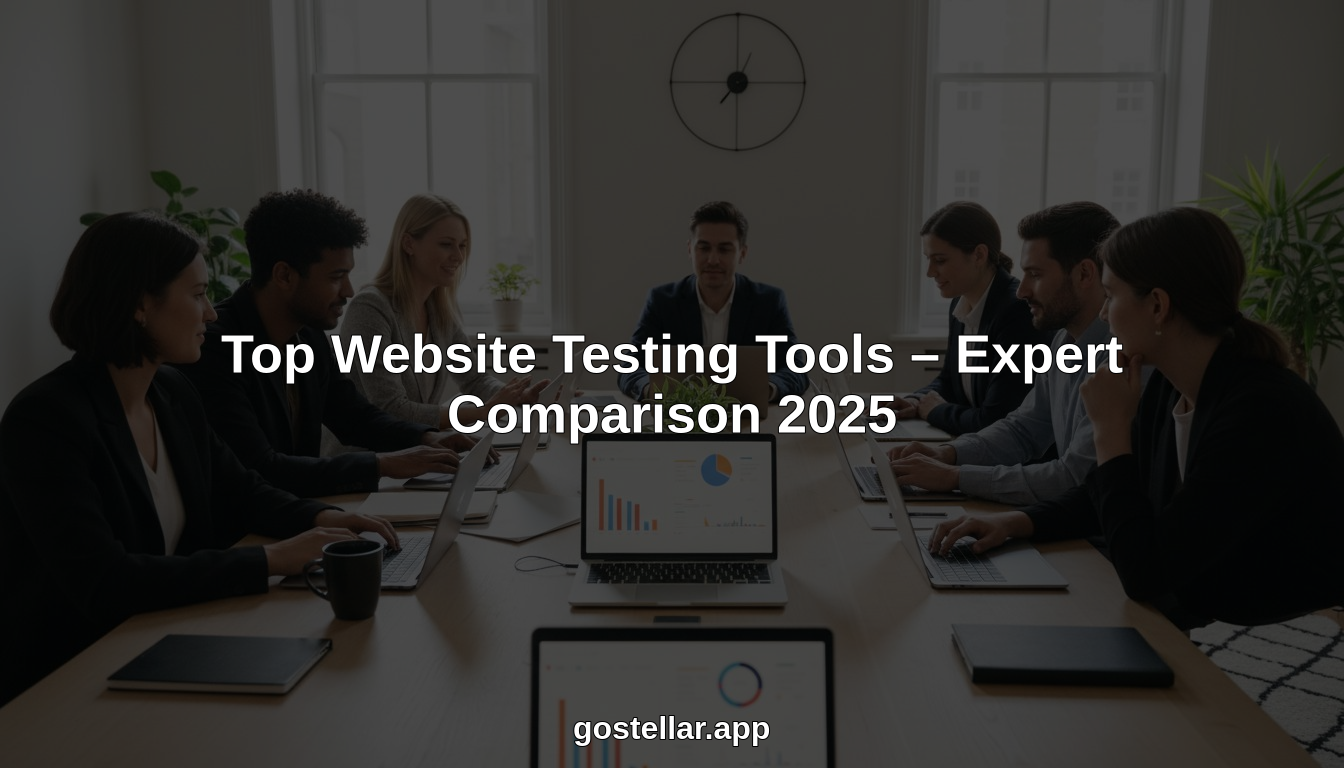
Top Website Testing Tools – Expert Comparison 2025

Choosing the right tool to test changes on your website can feel overwhelming. Some promise faster results while others claim to offer powerful insights with just a few clicks. Features range from visual editors that make simple tweaks easy to complex systems with deep analytics and advanced personalization. Each platform has its own approach and strengths. The differences in speed, pricing, and ease of use are bigger than most people expect. Understanding how these tools actually work in practice reveals surprises that could change the way you run experiments online.
Table of Contents
Stellar
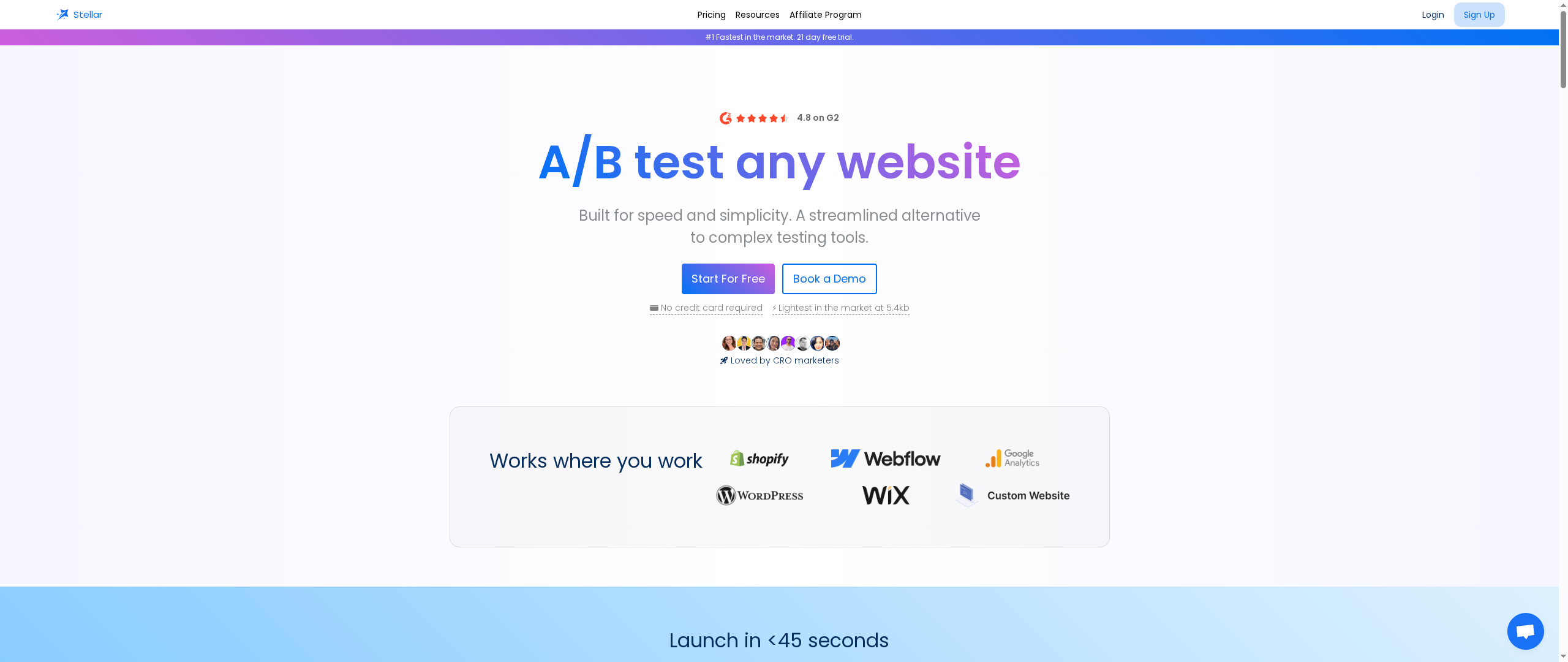
At a Glance
Stellar is a fast, simple A/B testing platform built for teams that value speed and clarity over complexity. Its lightweight approach, no-code visual editor, and real-time analytics let marketers iterate experiments quickly while keeping page performance intact. It’s particularly strong for small to mid-sized businesses that need robust insights without a heavy engineering lift. There are trade-offs: Stellar deliberately prioritizes speed and simplicity over the deep, enterprise-level feature sets found in larger platforms.
Core Features
Stellar bundles a pragmatic set of capabilities designed for rapid experimentation and clear decision-making. The visual web editor requires no coding, letting you change layouts and copy in minutes. Real-time performance analysis and AI-powered conversion insights surface winning variants fast, while integrations with GA4, Segment, and Mixpanel feed your analytics stack. Personalization is supported via dynamic keyword insertion for tailored landing pages, and advanced users can apply custom JavaScript and CSS. Operationally, Stellar uses fast CDN-based loading, cookie-free operation, and GDPR-conscious practices to minimize site impact, and billing is flexible based on monthly tracked users (MTU).
Pros
- Lightweight and fast: The platform is engineered to minimize impact on page speed, preserving user experience during experiments.
- No-code visual editor: Marketers and growth teams can set up tests without developer time, reducing cycle time from idea to data.
- Affordable, usage-based pricing: The pay-as-you-go model and free tier for up to 25,000 MTU lower the barrier to entry for smaller teams.
- Strong analytics and AI insights: Real-time reporting plus AI-driven recommendations accelerate confident decisions and reduce guessing.
- Easy integrations: Native connections to GA4, Segment, and Mixpanel make it simple to sync experiment data with existing analytics.
Who It's For
Stellar is built for marketers, CRO specialists, growth teams, and product managers at small to medium-sized businesses that need rapid, low-friction experimentation. If you run ecommerce, SaaS, or marketing sites and prioritize maintaining site speed while testing frequently, Stellar fits your workflow. It’s ideal when you want real-time feedback, simple personalization via keyword insertion, and a no-code path to iterate quickly without heavy developer dependency.
Unique Value Proposition
Stellar’s core promise is speed without compromise: fast test setup, near-immediate results, and minimal performance overhead. Unlike heavyweight enterprise tools that trade speed for feature bloat, Stellar focuses on the essential experimentation loop—create, test, learn—while preserving page experience with CDN loading and cookie-free operation. Its combination of a no-code editor, AI-powered conversion insights, and flexible MTU billing creates a clear value ladder for growing teams: start free up to 25,000 MTU, scale into a predictable Pro tier, then move to custom enterprise arrangements. For teams that measure outcomes in conversions per hour rather than dashboards per week, Stellar is purpose-built to outpace alternatives by turning hypotheses into validated actions faster.
Real World Use Case
A small e-commerce store uses Stellar to A/B test product page layouts. The marketing lead creates two variants with the visual editor, applies dynamic keyword insertion for ad-driven landing pages, and watches real-time analytics to identify a winner within days—improving add-to-cart rate while keeping site speed unchanged.
Pricing
Free tier available for up to 25,000 MTU; Pro plan starting at $99/month with additional charges per 1,000 MTU; Enterprise plans with custom pricing.
Website: https://gostellar.app
Optimizely
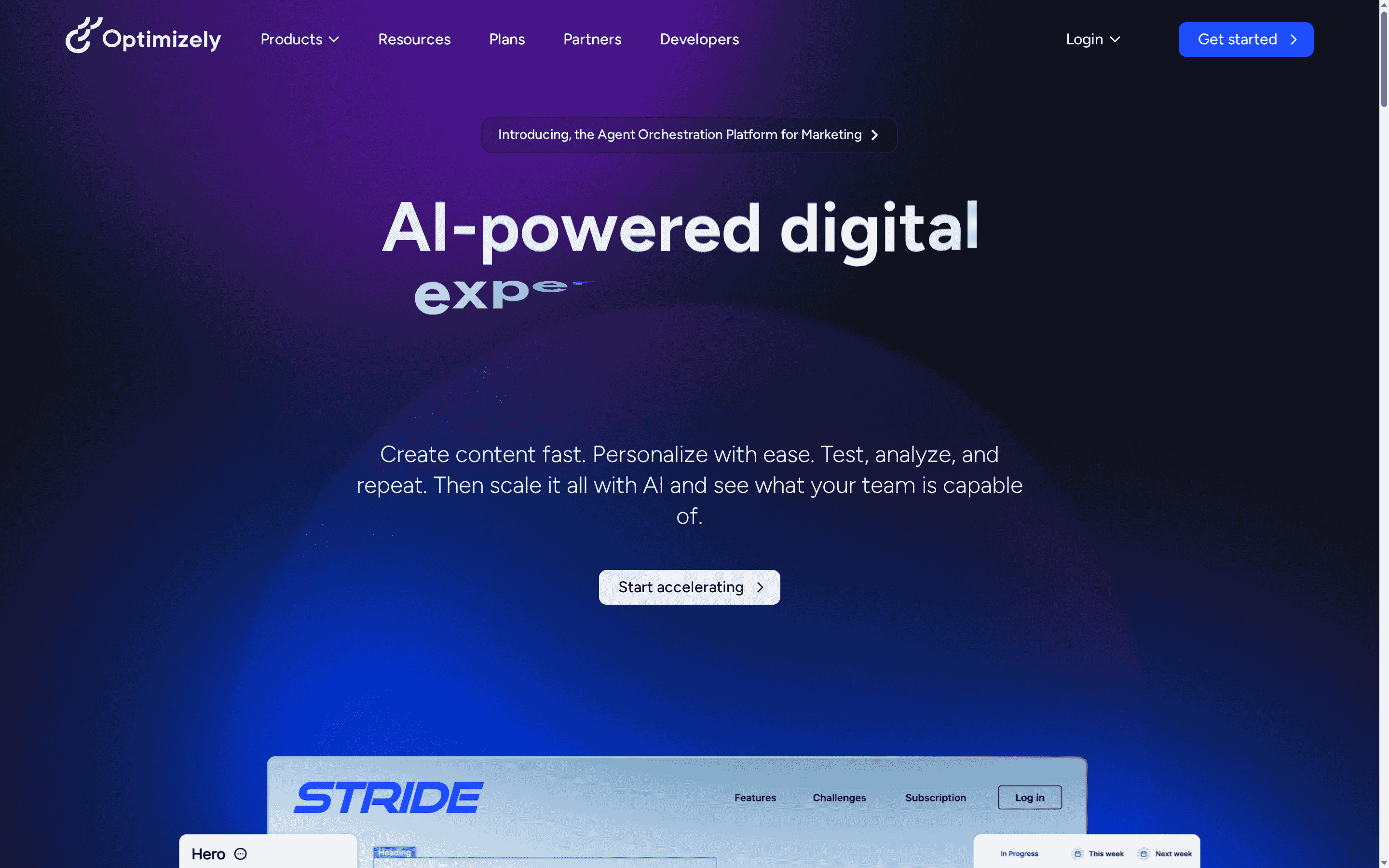
At a Glance
Optimizely is a full-stack digital experience optimization platform that bundles experimentation, personalization, content management, commerce, analytics, and a data layer into one enterprise-grade suite. If you need an all-in-one system to run experiments, deliver real-time personalization, and centralize analytics, Optimizely delivers a powerful, AI-driven toolbox. It’s robust and scalable — but that breadth translates to complexity and a pricing model that requires direct inquiry. Expect a capable platform, not a lightweight plug-and-play solution.
Core Features
Optimizely’s core strengths center on integrated capabilities: AI-powered experimentation and personalization to target users dynamically; a flexible content management system with APIs and headless deployment options; warehouse-native analytics and dashboards for deeper insights; commerce features that support multi-site and multilingual storefronts; and a real-time data platform for segmenting and activating customer data. Together these components let marketing and development teams create, test, and scale digital experiences across channels while keeping analytics and content in sync.
Pros
- Comprehensive suite integrating experimentation, content, commerce, and analytics: Optimizely reduces tool fragmentation by combining multiple capabilities into a single platform, which simplifies governance and cross-team collaboration.
- AI-driven personalization features for targeted customer engagement: Built-in AI helps automate how experiences are personalized, making it easier to serve relevant content without manual rule-heavy setups.
- Robust APIs and headless options for flexible deployment: Developers can decouple front-end presentation from backend content and experiment logic, enabling modern architectures and faster releases.
- Integration capabilities with various third-party applications: The platform is designed to connect with existing data and commerce systems so teams can leverage current investments rather than rebuilding pipelines.
- Tools designed for scalability and team collaboration: Features are aimed at enterprise workflows, allowing multiple teams to run experiments, publish content, and share insights at scale.
Cons
- Pricing information is not openly detailed, requiring contact for specifics: You must request a quote, which makes budgeting and quick evaluation harder for smaller teams.
- Potential complexity for new users due to extensive feature set: The platform’s breadth means a steeper learning curve and likely requires onboarding and cross-functional coordination to get full value.
- Limited specific reviews within the provided content: The supplied information lacks detailed customer outcomes or quantified case studies, which makes it harder to assess real-world ROI from the data given.
Who It's For
Optimizely suits marketing teams, digital experience managers, and development organizations that need a single, scalable platform to test, personalize, and analyze customer interactions. If your organization runs multi-site commerce operations, needs headless CMS flexibility, and can invest in implementation and training, Optimizely is a fit. If you’re a solo marketer or a small SMB seeking a lightweight tool, this might be overkill.
Unique Value Proposition
Optimizely’s unique value comes from bundling experimentation, content, commerce, analytics, and a real-time data platform under one roof with AI augmentation — enabling coordinated experiments and personalization across channels without stitching together disparate tools.
Real World Use Case
A digital retailer uses Optimizely to run A/B tests on product pages, deliver personalized product recommendations in real-time, and analyze engagement metrics in a unified dashboard to incrementally improve conversion rates.
Pricing
Quote-based (request pricing)
Website: https://optimizely.com
VWO (Visual Website Optimizer)

At a Glance
VWO is a full-featured digital experience optimization platform built for teams that need experimentation, personalization, and deep behavioral insights at scale. It combines A/B and multivariate testing with heatmaps, session recordings, and targeted personalization, all on an enterprise-ready architecture. If you run mid-sized to large sites or apps and need a single platform to run experiments and act on insights, VWO delivers — but expect a learning curve and plan complexity. Real muscle. Real complexity.
Core Features
VWO offers A/B testing, split-URL testing, multivariate testing, and multi-arm bandit experiments alongside heatmaps, session recordings, and funnel analysis to pinpoint conversion friction. Personalization tools let you target segments with tailored experiences across web, mobile, and server-side features, while an AI-powered Copilot (early access) assists with variation creation and idea generation. Integrations and compliance features are built for enterprise workflows and scale.
Pros
- Comprehensive experimentation toolkit: VWO combines A/B, multivariate, and bandit testing with analytics so you can run both simple and sophisticated experiments from one platform.
- Behavioral insights baked in: Heatmaps, session recordings, and funnel analysis give you visible, actionable data to diagnose where visitors drop off.
- Personalization across channels: You can target and personalize experiences on websites, mobile apps, and even server-side features, keeping experiments consistent across touchpoints.
- Enterprise-grade security and scalability: The platform is designed for larger organizations that require strict compliance and scalable infrastructure.
- Hands-on support and onboarding: VWO provides dedicated support and strategic guidance to help teams move from ideas to validated wins faster.
Cons
- Pricing complexity can be a barrier: The pricing structure varies by plan, visitors, and add-ons, which makes cost planning difficult without a custom quote.
- Advanced features often require higher tiers or add-ons: Some of the more powerful capabilities are gated behind growth/pro or enterprise plans, which raises the total cost for full functionality.
- Overwhelming for smaller teams: The breadth of features and configuration options can feel excessive for small businesses or teams new to experimentation.
Who It's For
VWO is designed for mid-sized to large businesses and enterprise teams that drive significant web or app traffic and need an integrated experimentation and personalization platform. It fits conversion rate optimization teams, product managers, and marketing ops leaders who value robust analytics, strong compliance, and vendor support.
Unique Value Proposition
VWO’s strength is its all-in-one approach: experimentation, behavior analytics, and personalization in one scalable platform backed by enterprise security and support. That combination reduces tool sprawl and centralizes experimentation workflows.
Real World Use Case
A retail organization uses VWO to A/B test product page layouts, personalize offers by segment, analyze session recordings to uncover UX friction, and then roll out winning variations across the site — resulting in clearer insight-to-decision cycles and improved conversion velocity.
Pricing
Quote-based. Pricing varies based on plan, number of visitors, and add-ons; plans include Starter, Growth, Pro, and Enterprise with custom enterprise options.
Website: https://vwo.com
Optimizely
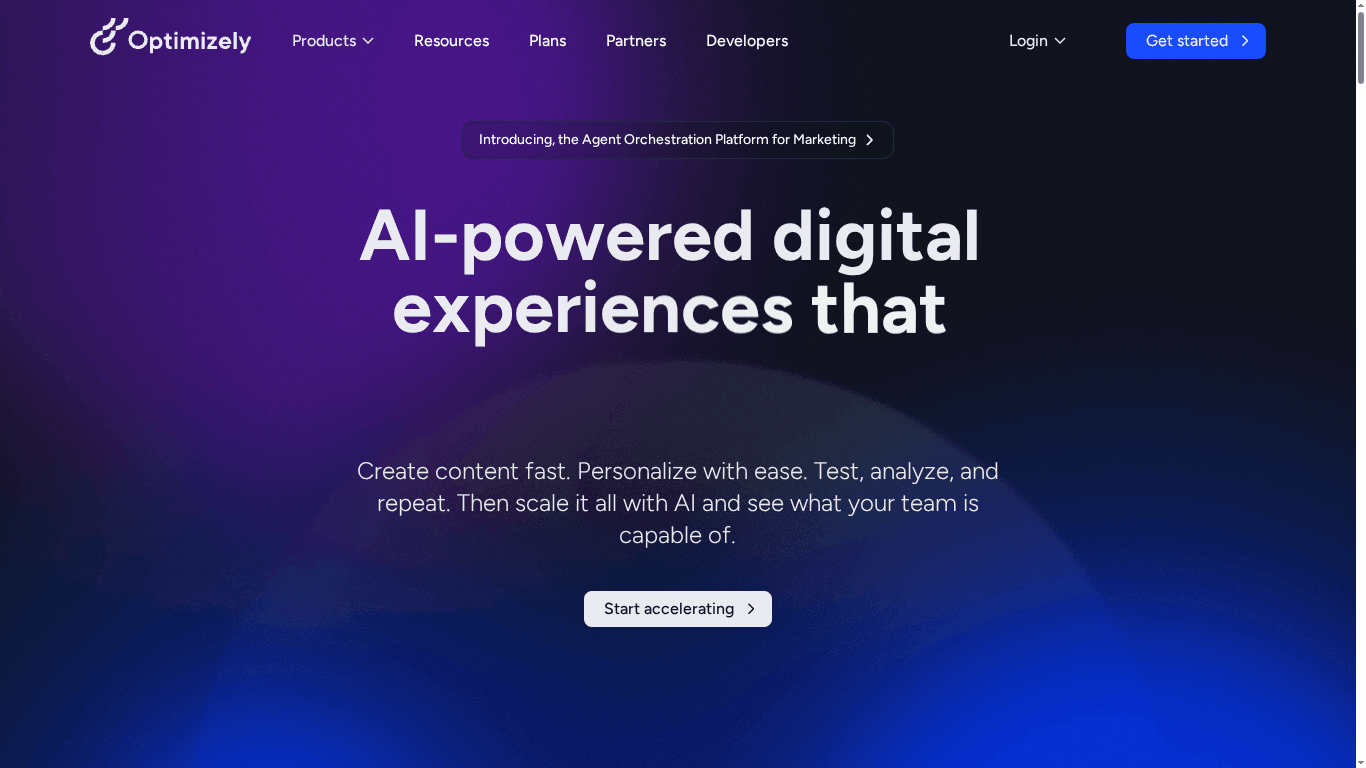
At a Glance
Optimizely is an AI-powered digital experience platform that combines experimentation, personalization, content management, and commerce capabilities into one suite. It’s designed to help marketing, product, and development teams run data-driven experiments and personalize journeys at scale. The platform’s strength is breadth: you get experimentation, CMS, DAM, and commerce under the same roof. That breadth brings power — and some complexity — so expect a learning curve and a sales conversation to get pricing aligned with your needs.
Core Features
Optimizely bundles AI-powered experimentation and testing with AI-driven audience targeting for personalization, a content management system for dynamic sites, and digital asset management for brand files. It also includes commerce capabilities to design and optimize customer journeys and built-in visualizations and analytics to measure impact and surface insights. The platform’s integrated approach aims to move teams from hypothesis to personalized, measurable customer experiences without stitching multiple point solutions together.
Pros
- Comprehensive suite for digital experience optimization: Optimizely brings experimentation, personalization, CMS, DAM, and commerce together so teams can operate from a single platform.
- Integrates with numerous apps and tools: The product is built to connect with other systems and workflows, helping you extend capabilities without rebuilding integrations.
- Uses AI to automate and enhance marketing efforts: AI-driven testing and audience targeting reduce manual segmentation effort and accelerate experiment iteration.
- Supports scalability for various business sizes: The platform is positioned to grow with you, supporting complex needs as teams and traffic increase.
- Offers tailored demos and flexible pricing options: Sales-led onboarding and customized pricing mean you can get a configuration and commercial model that matches your organization’s scale and goals.
Cons
- Complexity may require onboarding for new users: The breadth of features means teams should plan for training and implementation time to realize value.
- Pricing details are not specified and may require consultation for estimates: You’ll need to speak with sales to get concrete pricing, which can slow evaluation for smaller teams.
- Features may be extensive for small teams not needing advanced capabilities: If you only need simple A/B testing, the full suite may be more than required and introduce unnecessary overhead.
Who It's For
Optimizely is aimed at marketing teams, digital product managers, developers, and eCommerce leaders who need an enterprise-capable, AI-enabled platform to run experiments, personalize content, and manage commerce and content in a coordinated way. It fits organizations that plan to scale experimentation and personalization across multiple products or channels.
Unique Value Proposition
Optimizely’s unique value is its integrated AI-driven stack: experimentation, personalization, content, asset management, and commerce in one product ecosystem. That unified approach reduces friction between teams and centralizes measurement, making it easier to link experiments to business outcomes.
Real World Use Case
A company uses Optimizely to run A/B tests across landing pages, apply AI-driven personalization to key segments, and manage marketing content and assets centrally — enabling coordinated campaigns that are measured and iterated through a single analytics view.
Pricing
Quote-based — pricing is tailored to specific business needs and requires contacting sales for details.
Website: https://optimizely.com
VWO (Visual Website Optimizer)
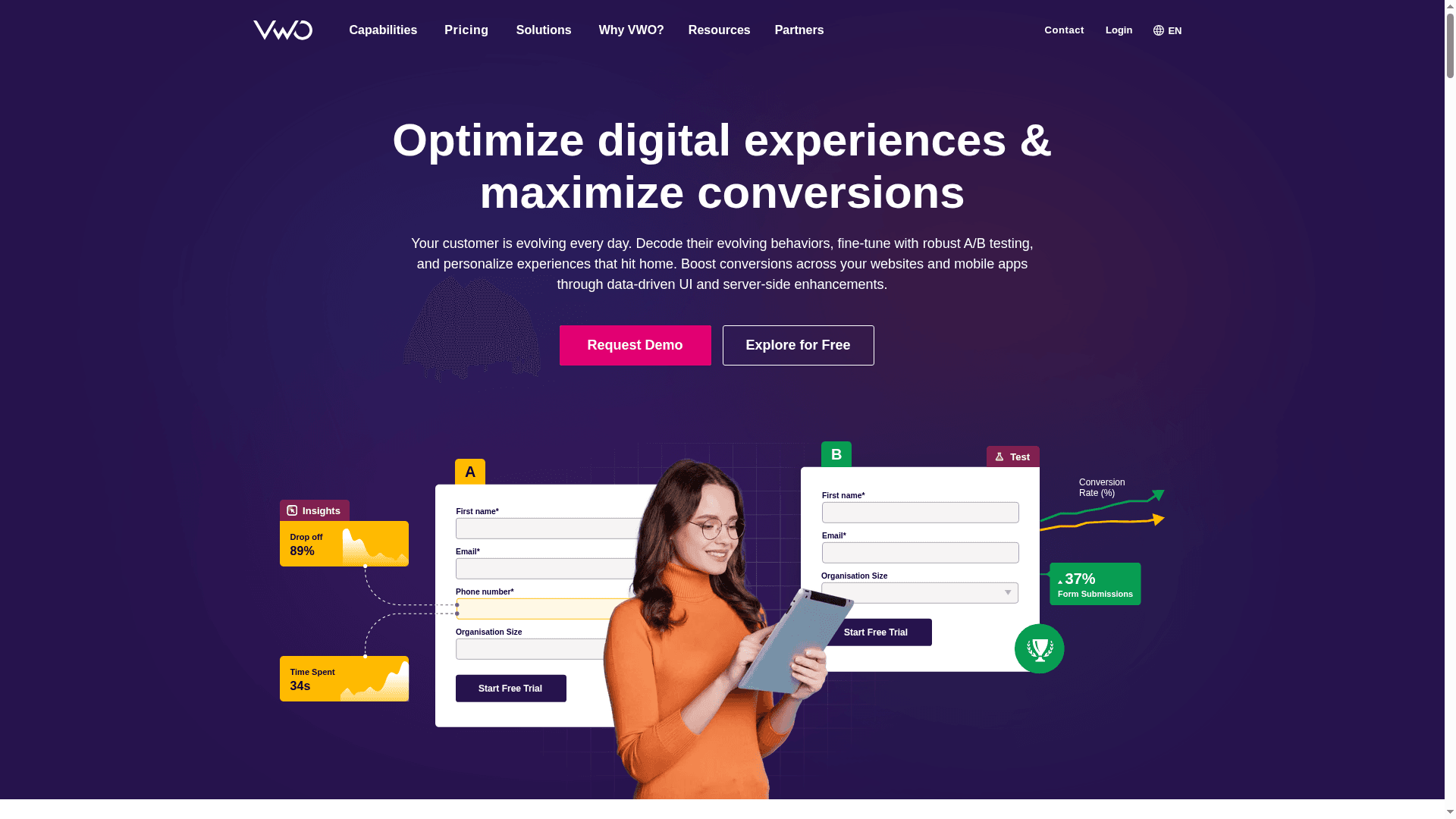
At a Glance
VWO is a full-featured digital experience optimization platform that combines testing, personalization, and behavioral insights to lift conversions across web and mobile channels. It emphasizes speed, privacy, and enterprise readiness while offering tools designed to minimize technical friction for marketing and product teams. For medium and large businesses that need scalable experimentation with strong governance, VWO delivers breadth and depth—at a price.
Core Features
VWO provides a broad toolkit for experimentation and behavior analysis: A/B testing, split URL testing, multivariate experiments, and multi-arm bandit testing sit alongside heatmaps, scrollmaps, session recordings, and click tracking. Personalization and targeted experiences are supported with advanced targeting (geo, device, technology, and custom segments) and both visual and code editors for building variations. The platform also emphasizes integrations and data unification so experimentation ties back to your analytics and business metrics.
Pros
- Robust experimentation and personalization tools: VWO supports a wide range of test types and personalization approaches, enabling complex optimization programs without stitching multiple point solutions together.
- Speedy implementation with asynchronous code and CDN technology: The platform is designed to reduce page impact and accelerate rollout, which helps preserve user experience during experiments.
- Comprehensive integrations and data unification: VWO is built to connect with analytics and backend systems so your test data and business reporting stay aligned.
- Enterprise-grade security, compliance, and dedicated support: The product targets organizations that require governance, security controls, and service-level support.
- AI-powered features like VWO Copilot for automation and insights: Built-in automation and insight tools help teams scale experimentation and discover winning variants more quickly.
Cons
- Pricing details often require tailoring and may be high for small businesses: The platform’s flexibility and enterprise focus mean that straightforward, low-cost plans for small teams are not emphasized.
- Complexity of features can be overwhelming for new users: The breadth of capabilities requires time and processes to manage effectively, especially for teams new to experimentation.
- Premium plans and add-ons can significantly increase total cost: Advanced capabilities and higher-tier support typically come at added expense, raising the overall investment for full functionality.
Who It's For
VWO is best suited to medium and large businesses seeking a scalable, enterprise-grade optimization solution. If you run a CRO program that needs advanced targeting, robust security controls, and integrations with existing data systems—or you have a centralized experimentation team—VWO matches those operational requirements.
Unique Value Proposition
VWO’s unique value lies in combining comprehensive experimentation types, behavioral analytics, and personalization within a single platform built for enterprise governance and speed. That single-vendor approach reduces integration overhead and helps teams move from hypothesis to validated outcome faster.
Real World Use Case
A retailer used VWO to run A/B tests and personalized product page experiences, then paired heatmaps and session recordings to refine UX changes; the combined approach produced a measurable uplift in conversion rate and average order value.
Pricing
Quote-based: pricing varies by features, plan type, and traffic volume, with options from starter to enterprise and custom pricing for large accounts.
Website: https://vwo.com
Digital Experience Optimization Tools Comparison
This table compares key features, pros, cons, pricing, and target users of the three digital experience optimization platforms highlighted in the article. It provides a quick reference for marketers and product managers to choose the best tool for their needs.
| Feature | Stellar | Optimizely | VWO |
|---|---|---|---|
| Core Features | No-code visual editor, real-time analytics, AI-powered insights | AI-powered experimentation, personalization, CMS, commerce | A/B testing, heatmaps, session recordings, personalization |
| Pros | Fast, no-code, affordable, strong analytics, easy integrations | Comprehensive suite, AI-driven, robust APIs, scalable | Comprehensive toolkit, behavioral insights, enterprise-grade security |
| Cons | Limited to simpler features versus enterprise solutions | Requires sales contact for pricing, complexity for new users | Complex pricing, advanced features require higher tiers, overwhelming for smaller teams |
| Pricing | Free for up to 25,000 MTU; Pro starts at $99/month | Quote-based, requires contact for details | Quote-based; varies by plan and add-ons |
| Target Users | Small to mid-sized businesses valuing speed and simplicity | Organizations needing integrated, scalable, AI-enabled platforms | Mid-sized to large businesses needing robust, scalable experimentation |
| Unique Value Proposition | Speed without compromise, no-code editing, flexible billing | Unified digital experience platform, AI automation | Single vendor for testing, behavioral analytics, personalization |
| Website | Stellar | Optimizely | VWO |
Accelerate Your Website Testing With Stellar
In the 2025 guide to top website testing tools you discovered the challenges of balancing fast setup with deep insights and minimal website impact. If you are a marketer or growth hacker frustrated by complex platforms that slow down your site or demand developer support Stellar offers a clear solution. With its no-code visual editor and lightweight 5.4KB script your experiments launch quickly without sacrificing site speed or user experience. Enjoy dynamic keyword insertion and advanced goal tracking that deliver personalized, actionable insights in real time to help you iterate and win faster.
Unlock the power of fast effective A/B testing designed specifically for small to medium-sized businesses seeking simplicity without compromise. Choose from flexible pricing tiers including a free plan for up to 25,000 monthly tracked users and see how your growth ideas turn into validated results with minimal effort. Visit Stellar and start transforming your experimentation strategy today.
Looking to boost conversions with a lightweight intuitive platform designed for marketers like you?
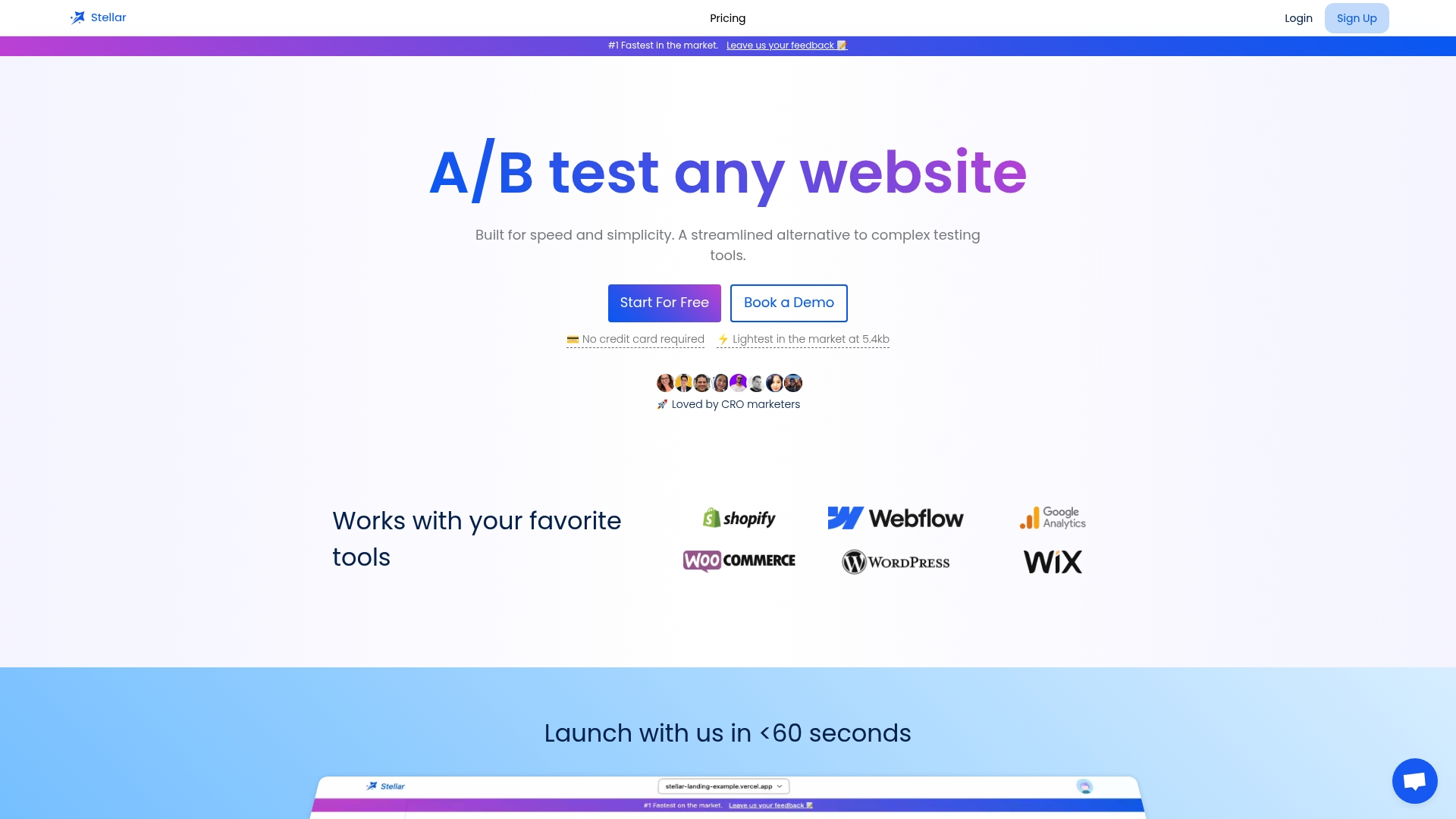
Explore the A/B Testing Tool built to minimize page load impact. Discover how the Visual Editor empowers you to launch tests instantly. Take control with our Real-Time Analytics and make confident decisions now. Visit https://gostellar.app and begin your fastest path to conversion growth.
Frequently Asked Questions
What are the main features to look for in website testing tools?
Website testing tools should include A/B testing, multivariate testing, heatmaps, and session recordings. Evaluate how well each tool integrates with your existing analytics and marketing platforms to ensure smooth data flow.
How can I implement A/B testing using website testing tools?
To implement A/B testing, choose a tool that provides a no-code visual editor. Create two or more variants of your web page or element, run the test for a set period, and analyze the results to identify the winning variant.
What measurements should I track during website testing?
Focus on conversion rates, bounce rates, and user engagement metrics. Use these measurements to gauge the effectiveness of your experiments and adjust your strategies within 30–60 days for optimal results.
How do I decide between a lightweight and a comprehensive website testing tool?
Consider the complexity of your testing needs and the size of your team. Lightweight tools are ideal for teams that prioritize speed and ease of use, while comprehensive tools offer advanced features for deeper insights and larger-scale testing.
Can website testing tools help improve site speed?
Yes, many website testing tools are designed to minimize impact on page loading times. Choose a tool that uses CDN technology and asynchronous loading to preserve user experience while conducting tests.
How often should I run tests using website testing tools?
Aim to run tests regularly, ideally once a month or whenever launching new content or features. This consistent approach allows you to iterate quickly and adapt to user behavior changes effectively.
Recommended
- Top 10 A/B Testing Platforms for 2025: Find the Best Web A/B Testing Tool for You
- Fast Testing, Fast Results: Speed-Focused A/B Tools for 2025
- Die besten WordPress A/B-Testing-Tools zur Optimierung Ihrer Website
- The Best WordPress A/B Testing Tools for Optimizing Your Website
- Top 4 Conductor SEO Platform Alternatives – Expert Comparison 2025
Published: 10/26/2025